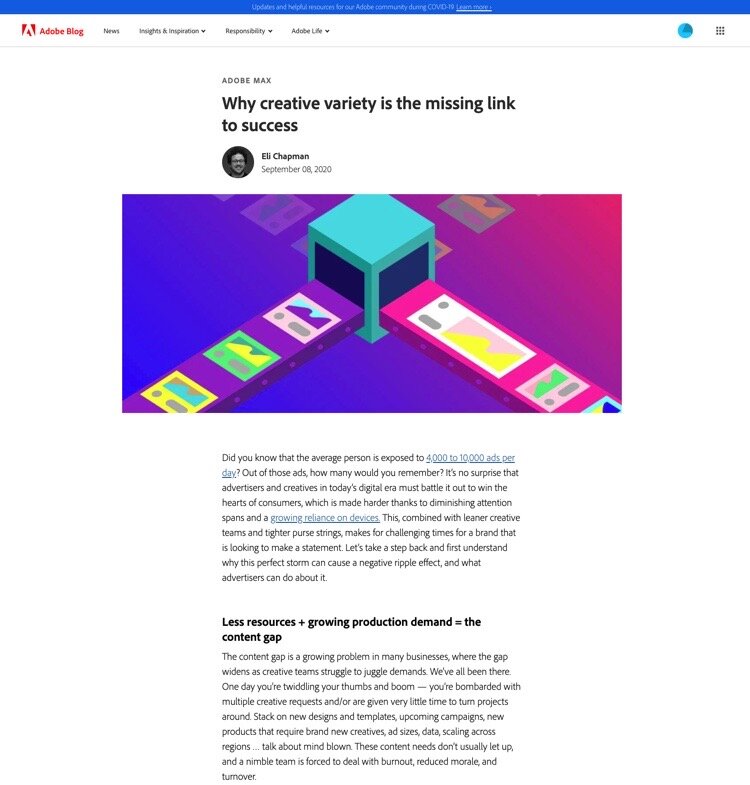Adobe x Celtra: Why Creative Variety is the Missing Link to Success
Did you know that the average person is exposed to 4,000 to 10,000 ads per day? Out of those ads, how many would you remember? It’s no surprise that advertisers and creatives in today’s digital era must battle it out to win the hearts of consumers, which is made harder thanks to diminishing attention spans and a growing reliance on devices. This, combined with leaner creative teams and tighter purse strings, makes for challenging times for a brand that is looking to make a statement. Let’s take a step back and first understand why this perfect storm can cause a negative ripple effect, and what advertisers can do about it.
Less Resources + Growing Production Demand = The Content Gap
The content gap is a growing problem in many businesses, where the gap widens as creative teams struggle to juggle demands. We’ve all been there. One day you’re twiddling your thumbs and boom — you’re bombarded with multiple creative requests and/or are given very little time to turn projects around. Stack on new designs and templates, upcoming campaigns, new products that require brand new creatives, ad sizes, data, scaling across regions … talk about mind blown. These content needs don’t usually let up, and a nimble team is forced to deal with burnout, reduced morale, and turnover.
A study by Forrester shows that 70 percent of brands are devoting more time to producing content than they would prefer. Imagine what a creative team could achieve if some of that time was given back to them? Creative Automation was designed to overcome these challenges, as it empowers marketers to efficiently produce creative in real time, connect the dots within creative teams, and ultimately out-market the competition.
Creative Automation and Creative Variety are the Perfect Pairing
An overwhelming 80 percent of brands say that their digital advertising strategy would benefit from improved creative technology, and creative automation platforms like Celtra help advertisers fight ad fatigue, facilitate a “test and learn” mindset, and optimize their content based on these findings. It is this approach that fosters a more nimble marketing organization that can quickly pivot messaging, content, and visuals in real time based on current affairs and cultural moments. This type of mindset only works if there is a wide swath of creative to learn from, which is where creative variety comes into play:
Variety and agility: COVID-19 has thrown the advertising industry on its head, and no one quite knows what is around the corner. Last-minute or live changes may need to be made to campaigns as a result. Creative Automation enables creative teams to easily tweak imagery and copy live across hundreds of variants through designing master templates. These content variations can be categorized into Content feeds, which lessens the load (and the associated time suck from having to source assets) for creative teams as it separates content from design and enables them to replicate and customize these master templates with desired content.
Scale creative assets at speed: What happens if you have multiple campaigns going live at once and your creative team is short staffed? Celtra Creative Automation produces master creative templates that can be customized and distributed across any market. This can shorten timeframes by 80 percent, a benefit we explore further in our recent webinar with Digiday, which you can watch on-demand.
Shift to e-commerce: The pandemic has forced brick-and-mortar to temporarily shut down, and calls for brands to think on their feet. The migration from offline to online, and creating assets to match would otherwise be a challenge. Creative Automation helps brands to quickly pivot to e-commerce to set up a new suite of creative assets, iterate existing campaigns, repurpose assets, and even expand these across to new channels such as social media and email.
Over the next five years, marketers expect automation to have the most powerful impact in increasing the volume of ad campaigns (84 percent) and improving creative quality (79 percent). In other words, both quality and quantity are set to be the norm, not the exception to the rule. If you have yet to jump on the bandwagon, now is the perfect time to discover how it can turn your creative team into a well-oiled machine. Send us a note anytime at marketing@celtra.com if you’d like to pick our brains further about this topic. We’re all ears!
Ghostwritten feature for Adobe x Celtra.
Read the original article here
